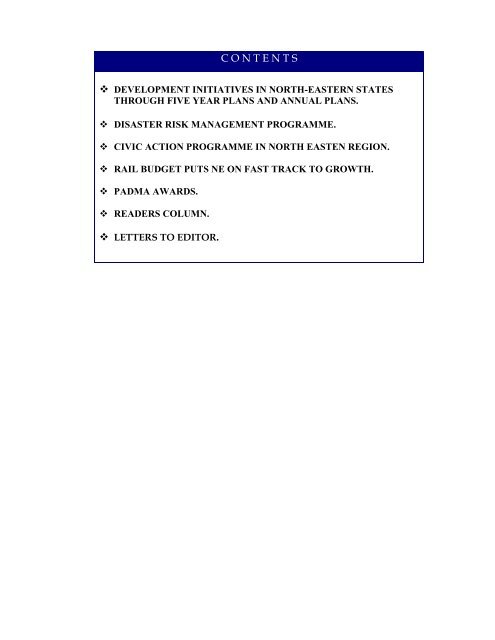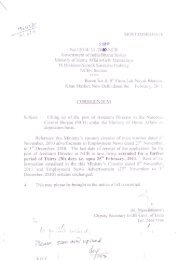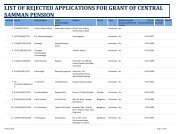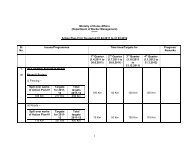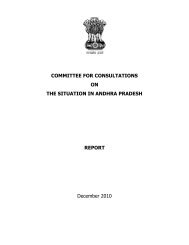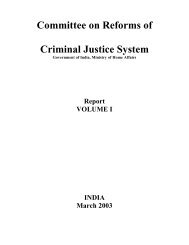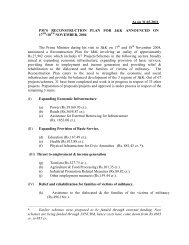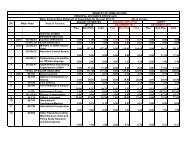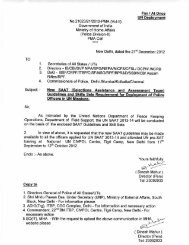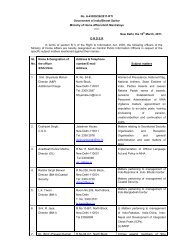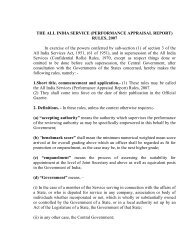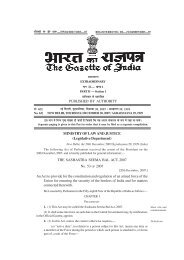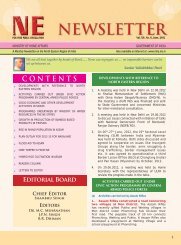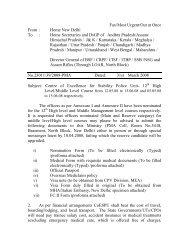C O N T E N T S - Ministry of Home Affairs
C O N T E N T S - Ministry of Home Affairs
C O N T E N T S - Ministry of Home Affairs
You also want an ePaper? Increase the reach of your titles
YUMPU automatically turns print PDFs into web optimized ePapers that Google loves.
C O N T E N T S<br />
DEVELOPMENT INITIATIVES IN NORTH-EASTERN STATES<br />
THROUGH FIVE YEAR PLANS AND ANNUAL PLANS.<br />
DISASTER RISK MANAGEMENT PROGRAMME.<br />
CIVIC ACTION PROGRAMME IN NORTH EASTEN REGION.<br />
RAIL BUDGET PUTS NE ON FAST TRACK TO GROWTH.<br />
PADMA AWARDS.<br />
READERS COLUMN.<br />
LETTERS TO EDITOR.
DEVELOPMENT INITIATIVES IN NORTH-EASTERN STATES THROUGH<br />
FIVE YEAR PLANS AND ANNUAL PLANS.<br />
(Source - Planning Commission)<br />
The Government has been resorting to various measures since independence for<br />
Socio-economic development <strong>of</strong> the people <strong>of</strong> the country and formulating schemes for<br />
development <strong>of</strong> infrastructure, education, culture, health, creating job opportunities etc. In<br />
the process, the special needs <strong>of</strong> particular sector in any State and State specific<br />
characteristics are also kept in view and exceptions wherever required have been made for<br />
ensuring balanced growth <strong>of</strong> the country including any region.<br />
Considering the geographical features and special characteristics <strong>of</strong> the NE States,<br />
Central Government Ministries have been resorting to formulating strategies/schemes even<br />
by making special concessions/dispensations in respect <strong>of</strong> the areas Administered by them.<br />
The programs/projects are aimed at improving the socio-economic infrastructure, creation<br />
<strong>of</strong> job opportunities, up gradation <strong>of</strong> culture, education, and creating economic base for<br />
bringing people to the mainstream.<br />
In this context, state specific position in respect <strong>of</strong> Meghalaya is as follows: -<br />
Meghalaya has a geographical area <strong>of</strong> 22,429 sq. km., shares 443 kms border with<br />
Bangladesh in the south and the west and is surrounded by Assam on the north-eastern<br />
side. Its surface area comprises mostly <strong>of</strong> hills and table lands with a small valley land.<br />
The State is endowed with rich natural resources, including forests, hydroelectric power<br />
potential and mineral deposits such as coal, limestone and uranium. The total area under<br />
forest cover is 75.08% <strong>of</strong> the total geographical area. Meghalaya has 7 districts and 5782<br />
villages. The population density was 103 persons per sq. km against the All-India density<br />
<strong>of</strong> 325 persons per sq. km. About 18.50 percent <strong>of</strong> the people in the State were below the<br />
poverty line in 2004-05 against all India level <strong>of</strong> 27.80 percent.<br />
The present road connectivity in the State is 37 Km/100Sq. Km which is much<br />
below the National Average (75 Km /100Sq. Km). About 51% <strong>of</strong> 5782 villages are<br />
connected by roads. The State is well endowed with mineral resources, with a coal reserve<br />
<strong>of</strong> about 560 MT and limestone reserve <strong>of</strong> about 12000 MT along with substantial deposits<br />
<strong>of</strong> industrial clay, kaolin, feldspar and uranium.<br />
Industrial development in the State especially in the SPIP, Byrnihat, industrial area<br />
near Umiam lake and Khliehriat sub station <strong>of</strong> Janitia Hills has taken place in the recent<br />
years.<br />
Meghalaya achieved a growth rate <strong>of</strong> 7.8% in the 9 th Plan. However, it fell to 6%<br />
during the 10 th Plan. The main reason is the inability <strong>of</strong> having infrastructure, particularly<br />
power to sustain and support high level <strong>of</strong> growth. For 11 th Plan, the growth target for the<br />
State is 7.3% against all India growth target <strong>of</strong> 9%. For achieving this growth target the<br />
State needs accelerated development <strong>of</strong> infrastructure especially power and road<br />
connectivity.<br />
2
From 2002-03 onwards, under Non-lapsable Central Pool <strong>of</strong> Reserved (NLCPR)<br />
funds, the <strong>Ministry</strong> <strong>of</strong> DoNER has sanctioned 24 projects at a total estimated cost <strong>of</strong> Rs.<br />
181.05 crore against which an amount <strong>of</strong> Rs 97.97 crore was released. Out <strong>of</strong> this, the 11<br />
projects mostly relating to power, roads, water supply scheme, housing, etc. with a total<br />
support <strong>of</strong> 79.48 crore have been completed.<br />
Approved outlay for the Tenth Five Year Plan for the State is Rs. 3009.00 crore,<br />
which is 20.33 percent higher than the agreed Ninth Five Year Plan <strong>of</strong> Rs. 2500.62 crore.<br />
Total outlay released during 2006-07 is anticipated at the level <strong>of</strong> approved outlay <strong>of</strong> Rs.<br />
900 crore.<br />
The aggregate proposed Plan size for 11 th Plan and Annual Plan 2007-08 for the<br />
State is Rs. 8695 crore and Rs. 1360 crore respectively. Compared to 10 th Plan and Annual<br />
Plan 2006-07, there is an increase in outlay <strong>of</strong> Rs. 5686 Crore (189%) and Rs. 460 Crore<br />
(51%) respectively. The proposed outlay for Annual Plan 2007-08 is 15.6% <strong>of</strong> the<br />
proposed 11 th Plan outlay.<br />
The State Govt. proposes to have rapid industrialization for improving employment<br />
and income by taking advantage <strong>of</strong> the North East Industrial Policy thereby encouraging<br />
heavy industries like cement plants and ferrous and non-ferrous industries with captive<br />
power generation. The State proposes to give priority to agriculture sector for improving<br />
livelihood <strong>of</strong> the people. Substantial investment is proposed in horticulture, bamboo<br />
exploitation to create employment and income, water management through minor<br />
irrigation, micro-irrigation and watershed development projects. Priority will also be<br />
accorded for imparting vocational training to the youth through polytechnics and IITs for<br />
developing employable skills<br />
DISASTER RISK MANAGEMENT PROGRAMME<br />
The Disaster Risk Management (DRM) Programme is a joint GOI-UNDP<br />
programme with the overall goal <strong>of</strong> sustainable reduction in disaster risk across India. The<br />
programme aims at developing the capacity <strong>of</strong> communities, government institutions and<br />
local self-governments in disaster mitigation, preparedness and recovery.<br />
A progress report <strong>of</strong> the main activities and special initiatives undertaken under the<br />
DRM programme in selected 169 multi hazard prone districts has been prescribed. These<br />
districts have been selected from the 17 States across India namely Arunachal Pradesh,<br />
Assam, Bihar, Delhi, Gujarat, Maharashtra, Manipur, Meghalaya, Mizoram, Nagaland,<br />
Orrisa, Sikkim, Tamil Nadu, Tripura, Uttaranchal, Uttar Pradesh and West Bengal.<br />
The main activities, classified under the Main Result Areas (MRAs), are as<br />
follows:<br />
(i) Disaster management Institutional mechanism and capacity building at all<br />
levels: This MRA encompasses activities related to sensitization, training and capacity<br />
building at all levels including government <strong>of</strong>ficials, volunteers and civil society. It also<br />
includes the constitution <strong>of</strong> disaster management department at the state level as well as the<br />
3
formation and training <strong>of</strong> disaster management committees (DMCs) and teams (DMTs) at<br />
all levels.<br />
• In Assam one <strong>of</strong> the significant achievements during the period has been<br />
heightened awareness <strong>of</strong> the need to institutionalize DM preparedness and response<br />
DM now forms an integral part <strong>of</strong> the agenda and priorities <strong>of</strong> the administration<br />
and community formations at different levels. It is now a part <strong>of</strong> the State Level<br />
Conferences <strong>of</strong> the District Magistrates and Superintendents <strong>of</strong> Police. Also, the<br />
DM related activities are being reviewed in all the District Development<br />
Committees meetings, indicating that it is now being recognized as a part <strong>of</strong> the<br />
development process.<br />
• Efforts to dovetail DRM into the ongoing State level Master Trainers (Teachers)<br />
and District level Resource Persons Training under Sarva Shiksha Abhiyan have<br />
been highly successful. Similarly dovetailing <strong>of</strong> DRM with NRHM (National<br />
Rural health Mission) is also being done. The training <strong>of</strong> components <strong>of</strong> DM and<br />
their role in DRM will commence soon.<br />
• Constitution <strong>of</strong> the DMCs is complete at the District and the Block levels. At the<br />
Gram Panchayat (GP) level it is about 99%, at the village level it is about 83% and<br />
at the Urban Local Body (ULB) level it is about 72%. The task, over the remaining<br />
period <strong>of</strong> the project is to build their capacities and response capabilities.<br />
• In Manipur Directorate <strong>of</strong> Relief and DM has been formed to streamline the<br />
implementation <strong>of</strong> the DRM programme. Infact, Civil Defence Organization’s<br />
involvement has strengthened the Department.<br />
• In Meghalaya the Department <strong>of</strong> Revenue has been re-designated as the Revenue<br />
and DM Department. State DM Authority has also been constituted but yet to be<br />
notified. DMCs have also been formed at the state level (headed by Chief<br />
Secretary), at the district (7) level, at the block (39) level and at the village level<br />
(4892). Apart from this, a DMT on Search and Rescue (S & R) has also been<br />
constituted.<br />
• In Nagaland provision for DM has been made in the annual budget <strong>of</strong> all<br />
departments working on it. DMCs (with 25 members) have been formed and<br />
members trained in all the 11 districts. 405 Village level DMCs have been formed<br />
in Tuensang, Mokokchung, Okha, Kiphire and Zunheboto districts, to expedite<br />
implementation <strong>of</strong> Village level activities under the DRM programme. The process<br />
for formulation <strong>of</strong> village level committees is going on in the rest <strong>of</strong> the districts <strong>of</strong><br />
the state.<br />
• DMTs (8) have also been formed in the districts vis-a-viz S & R, First Aid, Relief<br />
Distribution, Information Dissemination, Shelter Management, Water & Sanitation,<br />
Carcasses Disposal and Psychological/Trauma Counselling.<br />
4
• In Sikkim a coordination meeting <strong>of</strong> District Collectors, Assistant District<br />
Collectors, Sub Divisional Magistrates, Revenue Officers/ Additional Directors and<br />
staff members <strong>of</strong> the Land Revenue & DM Department was organized in<br />
September, 2006 in Gangtok, to discuss various day-to-day business issues to be<br />
executed under the department and the activities under the DRM programme.<br />
(ii) Sensitisation/ Capacity Building <strong>of</strong> DMCs/DMTs and Other Stakeholders<br />
• In Arunachal Pradesh a one-day DRM orientation <strong>of</strong> DDMC members (about 37<br />
<strong>of</strong>ficers from various departments including <strong>of</strong>ficers from outpost) was organized<br />
in December 2006, at Bomdila, in West Kameng district. This orientation<br />
programme was felt essential, as almost all the <strong>of</strong>ficers previously oriented under<br />
the DRM programme were transferred to other places in the state. After the<br />
orientation programme it was decided that all the departments would share<br />
information in the prescribed format for IDRN web portal and District Information<br />
Officer, NIC would be uploading and updating database at regular intervals. Also<br />
it was decided that all the line departments including the district administration will<br />
have to review the District DM Plan for further improvement.<br />
• In December 2006, a major fire broke out in the administrative building <strong>of</strong> the<br />
district hospital in Pasighat, due to an electrical short circuit, which caused huge<br />
damage to the assets and to one portion <strong>of</strong> the hospital building. This particular<br />
event compelled the hospital administration to organise the training programme for<br />
the doctors and other hospital staff on various aspects <strong>of</strong> DM, such as how to<br />
prepare the Hospital DM plan and the aspects to be taken into account while<br />
preparing it, structural and non-structural safety aspects required to minimize the<br />
chances <strong>of</strong> a disaster in the hospital. This fire accident in the district hospital<br />
exposed the vulnerability <strong>of</strong> the existing setup and also emphasized the need for<br />
DM system to be in place. A one-day training was orgainsed in December 2006 in<br />
this hospital, in which Deputy Director Health Services, all the doctors,<br />
administrative and nursing staff participated.<br />
• In Assam training <strong>of</strong> DMC members and other <strong>of</strong>ficials has been satisfactory with<br />
the following achievement levels i.e. District-100%, Blocks-74%, GPs- 65%,<br />
Villages-77% and ULBs – 32%. DMTs training in Search & Rescue (S & R) and<br />
first aid are also ongoing.<br />
• Progress <strong>of</strong> PRIs training has been very encouraging and this will go a long way in<br />
institutionalizing DM at the grass root levels. In the programme districts, a total <strong>of</strong><br />
6410 Village sensitization meetings have been organized till December, 2006.<br />
• Over and above the trainer from Civil Defence at the State level, for training in the<br />
area <strong>of</strong> S & R, the State has now developed its own resources with the development<br />
<strong>of</strong> 26 Master Trainers. The State Government has also undertaken several<br />
initiatives for the capacity building <strong>of</strong> its own personnel. A team <strong>of</strong> 12 State level<br />
Search & Rescue personnel were sent to NISA (National Industrial Security<br />
Academy), Hyderabad for a two months course on “Advanced training on Search &<br />
5
Rescue.” These trained persons will provide the State with specialized<br />
competencies, and build individual capacities as well.<br />
• In Manipur July 2006, State Academy <strong>of</strong> Training (SAT) organized a four days<br />
training programme on DM and responsibilities to carry out the DRM programme,<br />
in which 40 <strong>of</strong>ficials (including 12 women) <strong>of</strong> Thoubal DC Office, local NGOs<br />
Thoubal KMC members, PRI members, personnel from Nagar Panchayats, teachers<br />
etc, participated.<br />
• SAT organized a two-weeks training on S & R and First Aid for the personnel from<br />
Imphal Municipal Council with the support from Civil Defence organization. 76<br />
participants (including 49 women) most <strong>of</strong> them were from Mayang Imphal Bazaar<br />
(market), who attended this training, assured to form a S & R as well as First Aid<br />
Team for their Baszrs to respond at the time <strong>of</strong> emergency. During August 2006,<br />
the Academy also organized a three days training programme on DM (especially<br />
community based DM) for the Nodal <strong>of</strong>ficers <strong>of</strong> different departments.<br />
• During September 2006, in a three days training programme organized by the<br />
Academy at the School level in which 41 selected students (from Xth and XIth) and<br />
12 teachers were also given practical training in First Aid as well as S & R<br />
operations. Also, about 450 NSS volunteers and 50 teachers from schools in<br />
Imphal and one school at Lilong under Thoubal district and 42 NCC cadets at<br />
Thoubal were trained on DM, S & R and first aid by the Civil Defence<br />
orgainization. The training was organized by the NSS cell <strong>of</strong> Manipur. During the<br />
training, the students showed their enthusiasm to learn and practice more skills.<br />
The school authorities were also advised to prepare their school safety and<br />
evacuation plan.<br />
• In October 2006, a five-days training programme for the NCC cadets was<br />
organized on DM and DM plan preparation, at Thoubal in which 58 cadets<br />
belonging to 11 th and 12 th standards participated.<br />
• In Meghalaya regular trainings on DM for various stakeholders have been initiated.<br />
822 DMC members (including 17 % women), 2718 village headmen and more than<br />
400 Women SMG members have been trained on DRM and Community level<br />
DM, 314 DMC members have been trained on DRM, 192 <strong>of</strong>ficials have been<br />
trained on S & R and 203 members been trained on First Aid, organized by District<br />
Administration, 8037 VDMC members (including 19% women) have been oriented<br />
on Community based DM, 2630 VDMT members (including 11% women) have<br />
been trained on First Aid and 2853 volunteers (including 7% women) on S & R by<br />
Civil Defence and <strong>Home</strong> Guards at the Block and Village levels. A total <strong>of</strong> 3202<br />
Village sensitization meetings were organized.<br />
• Training <strong>of</strong> 52 Senior Officers, 59 Master Trainers on DM, 5 days practical training<br />
for more than 30 District level Senior/Nodal Officers on S & R was organized by<br />
the Department <strong>of</strong> <strong>Home</strong> (Civil Defence & <strong>Home</strong> Guard) at the State level. At the<br />
district level 226 (16% women) Block level Master Trainers (BMT) have been<br />
trained on various aspects <strong>of</strong> DRM with special emphasis to CBDM and Block DM<br />
6
Plan. 166 teachers at the District level and 2151 teachers at the Block level, 371<br />
NYKS/NCC/Scouts and Guides members, and 5179 volunteers at the block level<br />
have been trained on DRM.<br />
GUIDELINES FOR CIVIC ACTION PROGRAMME IN NORTH EASTEN<br />
REGION - FUNDS RELEASED TO ARMY AND CPMFs FOR CIVIC WORKS.<br />
******<br />
<strong>Ministry</strong> <strong>of</strong> <strong>Home</strong> <strong>Affairs</strong> had been releasing funds to Army and Central Paramilitary<br />
forces (CPMFs) for undertaking Civic Action Program in NE region. Funds are broadly<br />
utilized for the following purposes:<br />
(a) Construction and/or repair to community buildings to include schools,<br />
hospitals, health centers, community halls, market sheds, bus/taxi stands etc.<br />
(b) Developmental activities such as construction <strong>of</strong> tracks, small bridges, culverts,<br />
minor cableways, water supply, electrification schemes, playground etc.<br />
(c) Running <strong>of</strong> health, medical, dental, veterinary camps including provisioning <strong>of</strong><br />
medical equipments and stores etc. to existing hospitals/nursing homes.<br />
(d) Human Resources Development including imparting <strong>of</strong> vocational training,<br />
conduct <strong>of</strong> education excursions by the students to places <strong>of</strong> national interest<br />
and the like, organized career counseling, training and coaching etc.<br />
(e) Initiation <strong>of</strong> small projects in improvement and care <strong>of</strong> livestock, beekeeping,<br />
fisheries agriculture techniques, orchards, forestry, carpet and/or handloom<br />
weaving, hosiery etc.<br />
(f) Cost <strong>of</strong> transportation <strong>of</strong> stores for the execution <strong>of</strong> the above-mentioned tasks.<br />
DETAILS OF FUNDS RELEASED UNDER CIVIC ACTION PROGRAMME IN<br />
NORTH EAST REGION DURING THE YEAR 2006-07<br />
Name <strong>of</strong> Organization<br />
Indo-Tibetan Border Police (ITBP)<br />
Sashastra Seema Bal (SSB)<br />
Central Reserve Police Force (CRPF)<br />
Assam Rifles (AR)<br />
Border Security Force (BSF)<br />
7<br />
Amount released<br />
Rs. 80.64 lakh<br />
Rs. 61.63 lakh<br />
Rs. 74.15 lakh<br />
Rs. 290.00 lakh<br />
Rs. 91.00 lakh
Army<br />
Total<br />
8<br />
Rs.102.58 lakh<br />
Rs. 700.00 lakh<br />
RAIL BUDGET PUTS NE ON FAST TRACK TO GROWTH<br />
Railway Budget 2007-08 put the North East on the fast track. Four new national<br />
projects, including the construction <strong>of</strong> Bogibeel bridge over Brahmaputra, Rangiya-<br />
Murkongselek gauge conversion, Azra-Byrnihat and Dimapur-Kohima new line projects<br />
have been renamed ‘National Projects’.<br />
While announcing that Garib Rath will roll between Kolkata and Guwahati twice<br />
weekly, additional funds <strong>of</strong> Rs 2,725 crore were sought from the <strong>Ministry</strong> <strong>of</strong> Finance for<br />
four ongoing national projects, three <strong>of</strong> which are in NE. These projects include Jirbam-<br />
Imphal Road (Tupul) and Kumargaht-Agartala new line and Lumding-Silchar-Jiribam<br />
gauge conversion projects.<br />
As per the Railway Budget, the New Guwahati-Digary railway track will be<br />
double-lined. The Railway Minister also announced that on the demand <strong>of</strong> the honourable<br />
members, the survey work <strong>of</strong> Rupai-Parshuramkund new line has been proposed to be<br />
taken up.<br />
The Northeast Frontier Railway (NFR), as per the Railway Budget 2006-07<br />
witnessed a hike <strong>of</strong> 40% in fund allocation The allocation for NFR had increased by Rs<br />
300 crore in comparison to the 2005-06 budget.<br />
Total allocation for construction projects during the year 2006-07 has been<br />
earmarked at almost Rs. 900 crore that includes three national projects as well as Rs 230<br />
crore for the Bogibeel bridge and Rs 384 crore for new lines in NE.<br />
The Railway <strong>Ministry</strong> had also accepted proposals for development <strong>of</strong> Kamakhya<br />
(and Pandu) as the second passenger terminal <strong>of</strong> Guwahati, development <strong>of</strong> a goods<br />
terminal at changsari, unification <strong>of</strong> computerized passenger reservation system, extension<br />
<strong>of</strong> platforms to accommodate 24 to 26 coaches, extension <strong>of</strong> circulating area <strong>of</strong> Guwahati<br />
station and the setting up <strong>of</strong> multi disciplinary training center at Rangiya.<br />
Funds have also been provided in the budget for work pertaining to the setting up<br />
<strong>of</strong> Rangiya Division, improvement <strong>of</strong> passenger amenities in Guwahati, New Bongaigaon,<br />
Tinsukia and Rangiya stations.<br />
PADMA AWARDS<br />
Padma awards, namely, Padam Vibhushan, Padma Bhushan and Padma Shri, are<br />
amongst the highest and most prestigious civilian honours <strong>of</strong> the country. Introduced in<br />
1954, the first list <strong>of</strong> these awards was announced on 15 th August, 1954. Subsequently, the
awards have been announced on Republic Day each year. During the years 1978 and<br />
1979, no awards were conferred. Also, no awards were conferred during the years 1993 to<br />
1997 while certain public interest litigation challenging the constitutional validity <strong>of</strong> the<br />
awards was pending in the Supreme Court. The Constitutional validity <strong>of</strong> the awards<br />
having being upheld by the Supreme Court, the awards were resumed from 1998. Upto the<br />
year 2007, 3214 Padma awards (Padma Vibhushan, Padma Bhushan and Padma Shri) have<br />
been conferred in different fields <strong>of</strong> activities.<br />
(ii) The award is conferred for distinguished service in various fields <strong>of</strong> activities, such<br />
as, art, literature, medicine, social work, science and engineering, trade and industry,<br />
public affairs, sports, etc. All persons, without distinction <strong>of</strong> race, occupation, position or<br />
sex are eligible for these awards. As a rule, the award is not conferred posthumously;<br />
expect rarely, if a person has died recently (say within a year preceding the Republic Day<br />
on which it is a proposed to announce the awards) and in exceptional cases.<br />
(iii) Every year, nominations for Padma awards are invited from all State/ UT<br />
Governments, Ministries/ Departments <strong>of</strong> the Government <strong>of</strong> India, various institutes <strong>of</strong><br />
excellence, etc. Recommendations received from them and others, including Ministers,<br />
MPs, private bodies and individuals, are scrutinized by the Padma Awards Committee<br />
comprising eminent <strong>of</strong>ficial and non-<strong>of</strong>ficial members. The Awards committee makes its<br />
recommendations to the Prime Minister and the President for final approval. The names<br />
approved by the President are announced on the eve <strong>of</strong> Republic Day every year. In 2007,<br />
the following personalities from North Eastern States have been conferred Padma Shri in<br />
recognition <strong>of</strong> their talent and contribution: -<br />
(I.) In 2007, Padam Shri has been conferred on Pr<strong>of</strong>. (Ms.) Temsula Ao, a well known<br />
poet, fiction writer and academic from the North-East. Born on 25 th October 1945, Pr<strong>of</strong>.<br />
Temsula graduated with distinction from Fazl Ali college, Mokokchung under Guwhati<br />
University, Assam. She obtained her M.A. English degree from the same University,<br />
obtained the Post Graduate Diploma in the Teaching <strong>of</strong> English from the Central Institute<br />
<strong>of</strong> English. Pr<strong>of</strong>. Ao a Fulbright Fellow at the University <strong>of</strong> Minnesota, USA is currently<br />
the Dean, School <strong>of</strong> Humanities and Education, North Easter Hill University (NEHU).<br />
She has successfully guided several M.Phil and Ph. D scholars during her teaching career<br />
<strong>of</strong> NEHU.<br />
(ii) Pr<strong>of</strong>. Temsula served as the Director <strong>of</strong> North East Zone Cultural Center, Dimapur<br />
on deputation from NEHU. During her tenure at the center, she initiated and successfully<br />
completed the construction <strong>of</strong> a Heritage Museum at Shangyu village in Mon District <strong>of</strong><br />
Nagaland where the world famous 400 hundred year-old single-piece wooden sculpture <strong>of</strong><br />
unique features has been housed along with artifacts <strong>of</strong> historical significance from the<br />
Ahom era, which were gifted by an Ahom king to the forefathers <strong>of</strong> the hereditary Angh<br />
(King) <strong>of</strong> the Shangyu Territory <strong>of</strong> the Konyak Nagas.<br />
(iii) Pr<strong>of</strong>. Temsula is the author <strong>of</strong> several books among which, her book on Henry<br />
James is a standard reading for both Graduate and Post-Graduate students <strong>of</strong> NEHU. The<br />
other book called The Ao-Naga Oral Tradition is considered to be a landmark in the<br />
history <strong>of</strong> documenting the fast-vanishing oral lore <strong>of</strong> the tribes <strong>of</strong> North East India.<br />
Beside these, Pr<strong>of</strong>. Ao has four books <strong>of</strong> poetry and a recent book <strong>of</strong> short stories called<br />
9
‘These Hills called <strong>Home</strong>’ : Stories from a War Zone to her credit, one story from this<br />
book has been translated into German and published in an onthology and the book is in the<br />
process <strong>of</strong> being translated into Assamese. She has also contributed a number <strong>of</strong> articles to<br />
journals like Indian Literature <strong>of</strong> Sahitya Akademi, Indian Horizons <strong>of</strong> ICCR and the<br />
NEHU Journal as well as entries in the Assamese Encyclopedia Project: World Literature<br />
and Folk Literature Volume, 2002 and an entry on The Folklore <strong>of</strong> Nagaland has been<br />
published in the Greenwood Encyclopedia <strong>of</strong> World Folklore and Folk Life, 2006,<br />
Westport, Connecticut and London. A number <strong>of</strong> her poems and short stories have also<br />
been published in different anthologies.<br />
(iv) Pr<strong>of</strong>. Temsula was awarded the Shakespeare Prize by Guwhati University in 1973<br />
in connection with the decade-long celebration <strong>of</strong> the poet’s 400 th birth anniversary.<br />
____<br />
II. Shri Thingbaijam Babu Singh <strong>of</strong> Uripok Nooremthong, Takhellambam Leikai,<br />
Imphal West, Manipur a renowned artist <strong>of</strong> Manipuri classical dance and Manipur Nat<br />
Sankirtan Pung was conferred Padama Shri in 2007.<br />
(ii) Born on 11 th February 1936, Shri Singh received his initial taining in Meitei Pung<br />
from Guru Liasharm Apabi Singh. He subsequently learnt Manipur Ras under the tutelage<br />
<strong>of</strong> Guru Maisnam Amubi Singh. Working over long years in close association with Guru<br />
Amubi Singh as a disciple and assistant, he gained mastery over different aspects <strong>of</strong> the<br />
Manipuri classical dance tradition. He is today considered a rightful heir to his guru’s art.<br />
(iii) Shri Singh’s career as a teacher began in 1954 at the Manipur Dance College,<br />
Imphal as an assistant to his guru. Subsequently, after brief assignment at various<br />
institutions outside Manipur, he served as Director <strong>of</strong> Manipur Jagoi Marup, Imphal from<br />
1970 to 1980. Since 1982, he has been Principal and Pradham Guru at Jawaharlal Nehru<br />
Manipur Dance Academy, Imphal.<br />
(iv) Shri Singh is one <strong>of</strong> the most outstanding Pung artist <strong>of</strong> Manipur nata Sankirtana<br />
and a widely respected Ras guru. Over the years, he has trained a number <strong>of</strong> students, who<br />
are now performing with leading groups. Apart from teaching, preserving and extending<br />
his Guru Amubi Singh’s work, he has contributed to the Manipuri repertories several<br />
compositions and dance-dramas <strong>of</strong> his own. He has also published three books on Meitei<br />
Pung and Ras.<br />
(v) Shri Singh is the recipient <strong>of</strong> fellowship on Dance by Sangeet Natak Academy<br />
1970-71 under Guru Amubi Singh, Akhil Manipur Kalakar Samelan Award ‘Nritya<br />
Charya’ in 1984, ‘Sangeet Natak Award’ in 1991, Manipuri Sahitya Parishad Award<br />
‘Nritya Ratna’ in 1977, ‘Guru Tarunkumar Sanman’ in 2006 and ‘N.E.T.V. People Choice<br />
Award’ in 2006.<br />
____<br />
III Smt. Naorem Ongbi Neelamani Devi a renowned Master Craftsman <strong>of</strong> Manipur<br />
was conferred Padam Shri in 2007.<br />
10
ii. Born on 1 st September, 1938, Smt. Neelamani Devi received initial training in<br />
Pottery from her mother. In 1960, she was trained at Shanthal Pargana, Bihar in Pottery<br />
under the sponsorship <strong>of</strong> the ‘Khadi and Gram Udyog Mandal’, Bihar. After successful<br />
completion <strong>of</strong> her training, she worked as a Demonstrator in the Directorate <strong>of</strong> Industries,<br />
Government <strong>of</strong> Manipur. She left Government job after few years and returned to her<br />
village to do something for villagers. She established one ‘Pottery Training-cum-<br />
Production Center’ in 1966 with a view to imparting improvised modern methods <strong>of</strong><br />
pottery among the poor rural women <strong>of</strong> surrounding villages to enable them to produce<br />
more attractive designs to generate sustainable income from their products. She designed<br />
‘Mother-clay’ and because <strong>of</strong> her tireless efforts, the poor women <strong>of</strong> the village were able<br />
to produce standardized and most modern products which won International recognition<br />
for Thongiao village.<br />
iii. In recognition <strong>of</strong> her artistry in pottery, film Director Shri Mani Kaul produced a<br />
documentary film in 1986 titled ‘Mittee Aur Manab’. Her potter products fomed a scene in<br />
Mahabharata T. V. serial as well as first three French T.V. serial Mahabharata. Another<br />
documentary film on her pottery works was produced by Shri Aribam Shyam Sharma,<br />
renowned Manipuri Film Director. She has participated in the Festival <strong>of</strong> India in Sweden<br />
in the Ethnographical Museum <strong>of</strong> Sweden featuring Crafts Exhibition and Demonstration<br />
entitled ‘Five Indian Artisans’; demonstrated the Terra-cota Art <strong>of</strong> pottery in Hyogo<br />
Prefectual museum <strong>of</strong> Modern Art, Kobe, Japan titled ‘The Art <strong>of</strong> the Adivasi’;<br />
participated in the demonstration <strong>of</strong> the Indian Adivasi Art Exhibitions at Tobacco and Salt<br />
Museum in Tokyo, Tougen Museum in Shirane, Yamanasi; Saitama Prefectual Modern<br />
Museum in Saitama And Mithila Museum in Tokamachi and Nigata.<br />
iv. Smt. Neelamani Devi is the recipient <strong>of</strong> ‘Tulasi Samman Award’ from the<br />
Government <strong>of</strong> Madhya Pradesh in 1986, ‘National Award for Master Craftsman’ in 1986<br />
and a ‘Certificate <strong>of</strong> Honour’.<br />
____<br />
IV. Shri Sonam Tshering Lepcha a folk singer, composer, dramatist, social activist and<br />
a living symbol <strong>of</strong> Lepcha culture <strong>of</strong> Sikkim was conferred Padam Shri in 2007.<br />
ii. Born on 3 rd January 1928 in Darjeeling District, Shri Sonam enrolled in 10 Gorkha<br />
Rifles as a soldier in 1945 but could not continue as his elder brother died in action in the<br />
World War II. After World War II, the Govt. <strong>of</strong> West Bengal and its authorities at<br />
Darjeeling/Kalimpong organized volunteer forces against anti social elements <strong>of</strong> the<br />
nation. He voluntarily joined the organization and was appointed as Captain <strong>of</strong> Bong<br />
Busty Volunteer Group.<br />
iii. Shri Sonam has served as a social worker, true survivor <strong>of</strong> the Lepcha community,<br />
who believed that a man without culture is like a man without backbone. He organized the<br />
young and enthusiastic groups and led them to Kolkata in 1949 on Independence Day and<br />
presented first Lepcha dance. He has brought forward the unknown and unseen Lepcha<br />
Folk dances and songs through Publicity Film. He is a member <strong>of</strong> Committee constituted<br />
by Govt. <strong>of</strong> Sikkim for conferment <strong>of</strong> award in the field <strong>of</strong> folk dance/ music and drama <strong>of</strong><br />
ethnic communities <strong>of</strong> Sikkim<br />
11
iv. The Chogyl <strong>of</strong> Sikkim (King) Late Sir Tashi Namgyal appointed him as an<br />
Organiser for lepcha Songs and Dances in 1954. He became the first Lepcha Artiste in the<br />
Song & Drama Division, Darjeeling <strong>of</strong> Govt. <strong>of</strong> West Bengal in 1960 and first Lepcha<br />
song was broadcasted by the All India Radio, Kolkata. He circulated “ACHULEY”,<br />
monthly publication from 1967 to 1969 on to popularize the lepcha literature. He has<br />
composed, compiled Lepcha songs, and has done research on Lepcha Musical instruments<br />
(Pantong Pilit, Tumbok, Satsang etc.) and presented dance dramas on Lepcha folklore,<br />
popular all over Sikkim.<br />
v. Shri Sonam has written more than 400 songs and composed 102 folk dances and 10<br />
dance dramas. He has also written several popular songs. His folk tales and short stories<br />
have been published in the Lepcha text books upto Secondary level. He is the voice <strong>of</strong><br />
progress and unity among Lepcha Community.<br />
vi. Shri Sonam is recipient <strong>of</strong> National Sangeet Natak Academy Award 1995 and<br />
highest honour “Nur Mayel Kohom” and “Nur Mayel” awarded by District Lepcha<br />
association in 1973 and 1974 in honour <strong>of</strong> his contribution to Lepcha community.<br />
READERS COLUMN<br />
<strong>Ministry</strong> <strong>of</strong> <strong>Home</strong> <strong>Affairs</strong> would welcome inputs for the NE Newsletter from the<br />
Government agencies, institutions and individuals highlighting the area specific problems,<br />
special features including potential for tourism, environmental protection, developmental<br />
aspects or special efforts as could contribute to the socio-economic development <strong>of</strong> the<br />
North East. The views <strong>of</strong> intellectual/ pr<strong>of</strong>essionals like minded people in North-Eastern<br />
State highlighting area specific potential/ problems and possible measures for resolution<br />
thereto are also invited.<br />
It is requested that special articles/ columns should be sent in a hard copy format<br />
accompanied by floppy/ CD version. Special articles should be accompanied by an<br />
abstract <strong>of</strong> a maximum <strong>of</strong> 150-200 words. Papers should not have been simultaneously<br />
submitted for publication to another journal or news paper. Readers are encouraged to send<br />
comments and suggestions (300-400 words) on published articles to the Readers column.<br />
All letters should have the writer’s full name and postal address.<br />
LETTERS TO EDITOR<br />
I have gone through NE Newsletter and found it very informative about the NE as<br />
well the various developments scheme taken by the Govt. <strong>of</strong> India. Let our NGO be<br />
recommended <strong>of</strong> the regular subscriber for this newsletter. We request you to kindly put<br />
our NGO also in your mailing list. We would appreciate if you send regularly the<br />
Newsletter.<br />
12<br />
(K Shantikumar Singh)<br />
General Secretary
13<br />
Organization for Rural Improvemtn<br />
Nambol Bazar, Manipur – 795134<br />
Most respectfully, I beg to state that kindly send me NE Newsletter copy free as<br />
regularly at the given address.<br />
Moniruzzamam Miah<br />
Village & PO – Kharmuza<br />
District Goalpara – Assam - 783101<br />
.<br />
With due respect, I beg to state that I came to know that you are publishing a<br />
monthly magazine “NE Newsletter”. Therefore I request you to send the magazine.<br />
Dr. R.R. Kar Purkayastha,<br />
4 Sonali Complex,<br />
Ambicapatty, Silchar,<br />
Assam- 788004


